While we humans are fighting all over the world, killing children, women, and men, as well as doing in all kinds of rare beasts such as elephants, rhinoceroses, scaled anteaters, and whales for keepsakes, the local fauna are raising families. And I imagine, except in the war-torn and poached parts of the globe, they are doing the same the world over. It is a pity that the most intelligent animal of all lags behind the others even though this very same animal is a reader, polyglot, writer, emailer, and maker and user of all tools ever devised.
Outdoors
Biogeography is the study of flora and fauna and how they got where they are today. It also applies to humans. We are pretty sure that Asians began to settle North America not quite 20,000 years ago when glaciers covered half of the northern hemisphere and sea level was 100 feet or so lower than today. Many, if not all, came by way of the “land bridge,” now submerged, between Siberia and Alaska. Many mammals and other vertebrates came to the Americas by the same route.
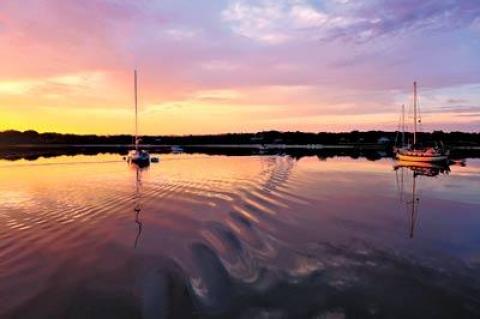 Stop, Hey, What’s That Sound?
Stop, Hey, What’s That Sound?It’s hard to describe. The sound was a rapid quacking like pleading ducks. No, it was more a staccato croaking, frogs imitating a motorcycle, frogs ululating, but it had to be a species of goose I’d never heard before passing by the sloop Leilani on her mooring as I lay on my bunk in the middle of the night that had fallen through Friday’s gloom.
Naming has come a long way since the days of yore. Now it is used to immortalize individuals, mostly politicos, famous athletes, fallen war heroes, and firemen and police shot in the line of duty. It is also used to name new roads in new subdivisions before they exist and to rename existing roads, beaches, parks, libraries, bridges, museums and the like. There are so many things to name and rename it boggles the mind — so many names that there should be a department of naming.
Jason Behan said it was like that scene in “Jaws” when the residents of Amity go to sea after the killer shark in every manner of craft and with every sort of weapon imaginable. He wasn’t talking about the weekend’s shark tournament. He was describing the scene that has continued to unfold around Montauk Point in recent days with a growing fleet of fishing boats converging on a school of striped bass, the likes of which veteran anglers say they have never seen.
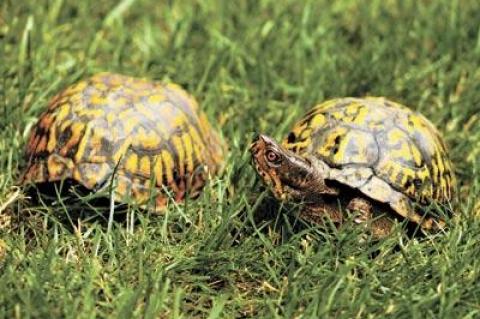 Nature Notes: A Salient Slap
Nature Notes: A Salient SlapIt seems like we are halfway through summer, but in reality we’re less than a third through. The roads are already super-clogged with vehicles, many of which are spiffy and go from 0 to 60 in less than 10 seconds, which is all well and good if you are on the Autobahn, but on Old Northwest Road or Accabonac Highway it’s a bit much.
 On the Stories Remaining
On the Stories RemainingMost every experienced surfer knows how to rate the pucker factor in increments of fear, as happened early evening on the Fourth of July in Montauk. Dozens were caught off guard by a rapidly building swell and forced to “scratch for the horizon” — paddle seaward to escape a serious pounding.
The Riverhead Foundation for Marine Research and Preservation freed an 800-pound leatherback sea turtle on Sunday that had gotten entangled in a lobster trap line in the ocean about a mile offshore.
First, a short note to cheer you all for the 4th of July. On Monday I received a communiqué from Kara Jackson, who handles the news for the Nature Conservancy. She said the first eagles to breed on Mashomack, the Nature Conservancy’s pearl on Shelter Island, in more than a century are just about to fledge their chicks. They could easily be in the air on the 4th. Wouldn’t that be terrific?
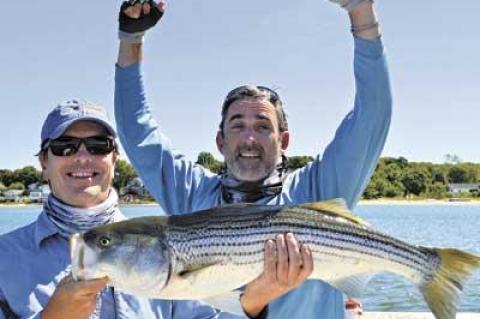 The Future Is Now
The Future Is Now“This year we have five satellite tags.” Carl Darenberg, owner of the Montauk Marine Basin, said casually on Monday, with every expectation that I would understand what he was saying. How strange. The “satellite-tag” sentence speaks to our time, late June 2014, and this place, Montauk. Imagine explaining its meaning to someone prior to Oct. 4, 1957, the day the Soviet Union put the first satellite into space.
In these parts, the accomplishment was memorialized by baymen, who named the slimy seaweed of mysterious origin plaguing the bay at the time “sputnik grass.”
On the evening of June the 11 I drove 43 miles on the back roads in Southampton Town listening for the breeding calls of whippoorwills and chuck-will’s-widows. I’ve been living in Noyac for 35 years and discovered a paved road right down the block that I had never been on, Old Sag Harbor Road, which connects Brick Kiln with Millstone Road where the old Bridgehampton Racetrack was situated.
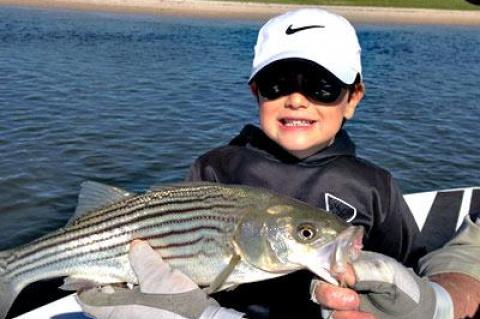 Seals, Sharks, and Surfers
Seals, Sharks, and Surfers“There’s something going on in the ocean,” Chuck Weimar said as he strode along its shoreline on Sunday. Naturally, something always is, but to hear it from the veteran fisherman, captain of the Montauk dragger Rianda S, meant the “something” could be abnormal.
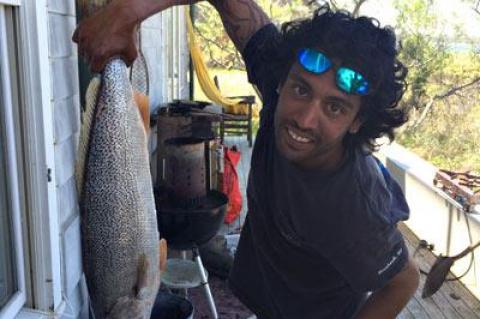 And the Eyes Have It
And the Eyes Have ItWhen pressed during an afternoon sail aboard the sloop Leilani on Monday, Dr. David Nelson allowed that before slipping into semiretirement two months ago he’d helped restore vision to 15,000 eyes, give or take, over the course of his 40-year career as an ophthalmic surgeon. What those eyes might have missed!
Earlier in the day, he’d peddled his bike from Montauk to East Hampton and back, then paddled out for a short surf session in shapely, waist-high waves at Ditch Plain not far from his house. The doctor complained of knee pain, and why not?
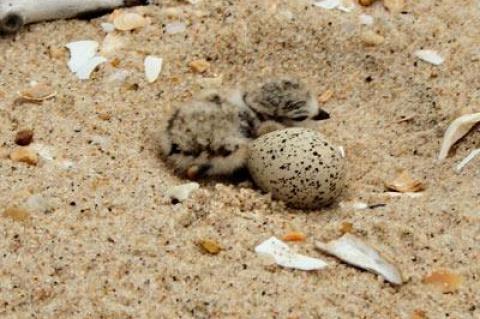 Nature Notes: Long Day’s Journey
Nature Notes: Long Day’s JourneyWe are on the verge of the longest day of the year, the summer solstice. For those living on the equator, it’s just another day. For those on the tiny island of Spitzbergen in the Arctic Ocean off the northernmost coast of Norway, there will only be day, no night.
 Blessings and Jackpots
Blessings and JackpotsShark tournaments are upon us. The captain’s meeting and beer bash for the Star Island Yacht Club’s 28th annual will take place this evening — entry fee, $1,000 per boat. The chum will flow Friday and Saturday, and sharks will be hoisted up the gibbet to be ogled, weighed, and necropsied.
Somewhere around $30,000 in prize money will be dispensed during the awards ceremony Saturday night, not counting the pool of much larger side bets. God help us.
The cosmos is expanding at an accelerated rate. There are thousands of meteorites ranging in size from a hardball to an aircraft carrier in crazy orbits and asymmetric paths in our solar system; small ones hit the earth annually. A big one like the one that smacked down in the center of Russia last year could hit somewhere in America within the next 10 years. The earth is pockmarked with craters from the strikes of asteroids and meteorites, as is the moon.
 Nature Notes: Orchids Abound
Nature Notes: Orchids AboundMy first 21 years were spent on the North Fork looking at this and that. While I specialized in birds, learned the mammals — there weren’t that many — I also knew the local frogs, turtles, newts. and fish, which I learned by catching them. I knew as many garden and farm plants as native plants, I knew that Japanese honeysuckle was not American, and I knew about a handful of other invasives. I knew blueberries, beach plums, black cherries, because I picked them and ate them. I knew poison ivy because it made you itch like the devil.
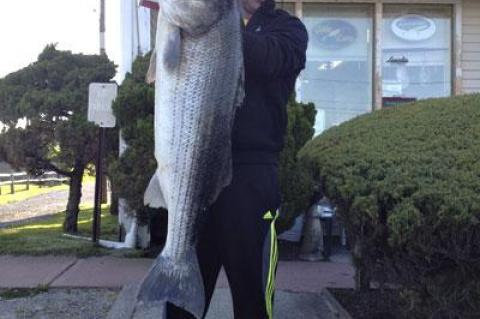 Stripers Are Big, Very Big
Stripers Are Big, Very BigLife: The symphony of birds, thousands of them greeted the sun on Monday morning. Surfers, hundreds of them, awoke to paddle into a surprise east swell that arrived during the night with an offshore wind to sculpt near-perfect waves. Surfcasters greeted the news that big, very big striped bass were caught from the rocks in Montauk’s moorland coves during the night.
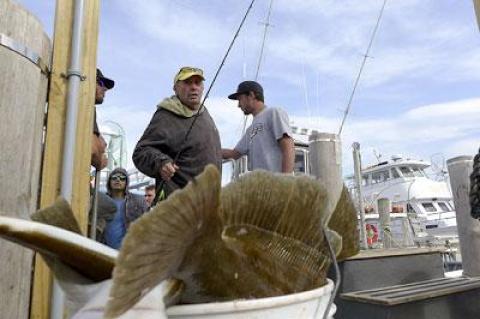 In the Undercurrent
In the UndercurrentThe instructions were straightforward: “Put ice, a Ziploc bag, and a 20 in the cooler. I’ll call you when he makes the drop.”
Like a beer-fueled, slam-bang game of Foosball at Liar’s Saloon, the fish deal was proof that a healthy undercurrent of local life continued to flow as the surface trickle of spring visitors swelled to a flood over the Memorial Day weekend.
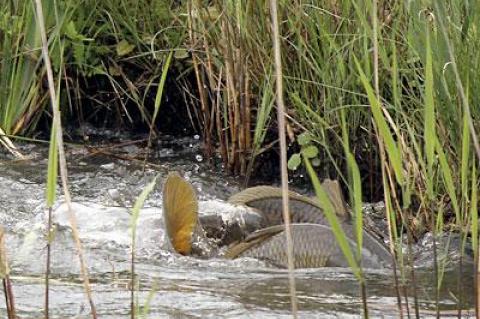 Nature Notes: As American As . . .
Nature Notes: As American As . . .Terry Sullivan is one fisherman who has been around. He fishes the ocean, bays, harbors, tidal creeks, ponds, and trout streams such as the Nissequogue. He’s caught just about every fish that will hit a lure or a fly from a shore at one of the above. He’s seen just about everything fishwise on Long Island, but last Thursday morning he was a bit flabbergasted to find a fish that he never caught here and, maybe, one that he never saw here.
The only butterfly I’ve seen to date is the cabbage white, the one long from Eurasia that lays its eggs on members of the cabbage family, to wit, garlic mustard, wild radish, and the like, also from Eurasia.
Butterflies and moths are part of the second trophic food level; they feed on the first level, the “producers.” In fact most insects — grasshoppers, various ant species, bees and other nectiferous species, almost all beetles and almost all bugs — feed on plants.
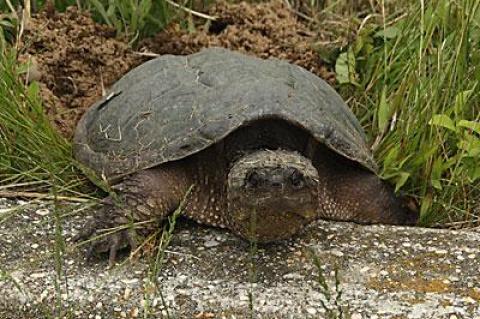 A Turtle Rescue Mission
A Turtle Rescue MissionMy wife, Kyle, is a sensitive person. She says this is why she adopts a hard exterior at times, a shell, like a turtle. I know this to be true. It’s also why she feels simpatico and keeps her eyes peeled for turtles making their equivalent of a mad dash across Montauk’s roads this time of year.
She always stops to help them lest they be flattened by insensitive drivers. On Monday morning, she called me from the road. She was on the way to work and spotted “a big, very big” turtle on the west side of Flamingo Avenue. “Can you come get it?”
A very active week in birdland, indeed! Topping the list of May returnees were ruby-throated hummingbirds. The first to return to the South Fork, perhaps, were the four that showed up at the house of my Noyac neighbor Ellen Stahl on May 6. She called to tell me that they were back, she had her hummingbird feeders up, and they were flying in my direction every once in a while. She thought they might nest in my backyard.
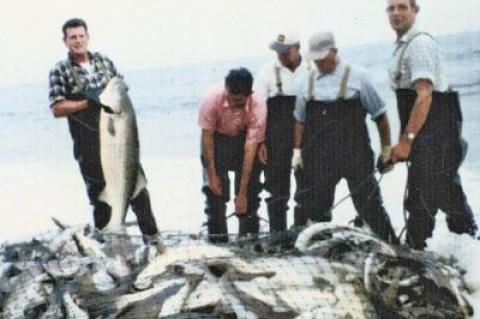 The Great Injustice of ’92
The Great Injustice of ’92Driving down Bluff Road in Amagansett on the sunny morning of July 28, 1992, I looked up and watched an osprey flying landward with a small striped bass in its talons.
I was en route to the protest of a new state law that banned the ocean seine as a means of catching striped bass. The regulation capped a decades-long effort on the part of powerful sportfishing interests, in cooperation with UpIsland politicians, to cripple the East End’s inshore commercial bass fishery.
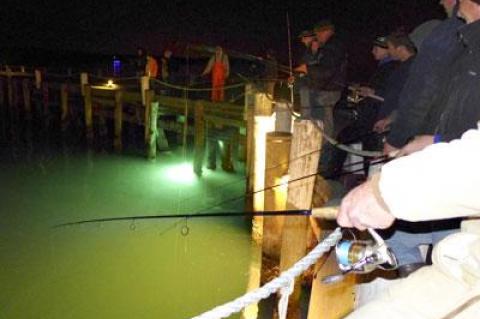 Divining Rods of the Deep
Divining Rods of the DeepAn infinity of tiny fish darted and gathered in the green glow of a submerged squid lamp on Monday night. The long tentacles of a pulsating jellyfish swept for food in the slow current. Time passed. Larger fish jetted through the small, lighted section of bay carved out of the night by the lamps. “Bunker,” a voice declared, breaking a long silence.
On Monday I took a drive through the hills of Noyac, Bridgehampton, Water Mill, and North Sea that make up the bulk of the so-called terminal moraine left by the glacier that retreated 15,000 or so years ago. When I moved back to Long Island from Oregon and California in 1974, those hills were only sparsely covered with houses. The pitch pine and oaks carpeted the ups and downs of the knob-and-kettle topography, and to the south, the farm fields spread from west to east as far as the eye could see. How things have changed.
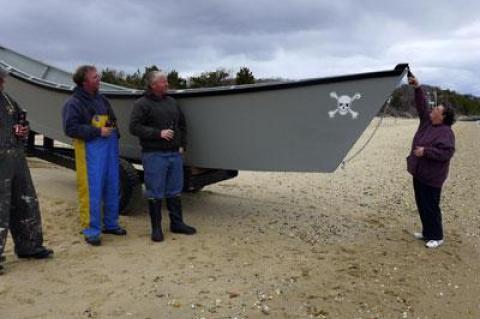 Mind Follows Where Lures Go
Mind Follows Where Lures GoI was walking east in one of Montauk’s moorland coves the other day and saw a lone surfcaster heading toward me. It was Eric Ernst, wetsuited, with casting rod on his shoulder. He had been testing the waters. We fell into conversation as the cove’s spring green waves thumped and whispered.
He confirmed what I’d heard earlier in the day. Small striped bass were being caught from the beach in recent days at Ditch Plain Beach and just east in front of the Montauk Shores Condominiums.
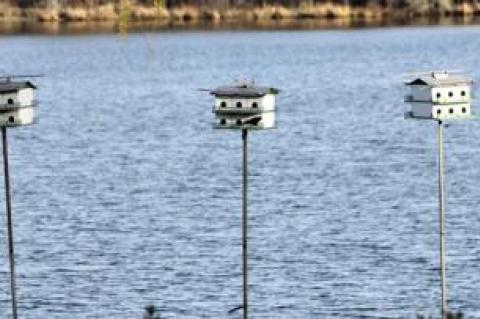 Nature Notes: Moment We’ve Waited For
Nature Notes: Moment We’ve Waited ForBy the time this publishes, we should have blossoms on the shads, sweet cherries, and beach plums, the bird’s-foot violets will turn certain road shoulders purple and the dogwoods in Northwest will be trying to expand their snow-white bracts (they don’t have petals).
I don’t go anywhere without my white tick towel; I even have it at hand in the winter. You never know what will happen on a very warm January day. I went out for a walk around Trout Pond in Noyac last Thursday followed by a longer walk Saturday afternoon around Big Reed Pond in Montauk. You may remember that Thursday was very cold with a brisk wind. Saturday was nice and warm and quieter.
The former Salivar’s, Montauk’s iconic, dockside eatery, reopened during the past week following an impressive renovation inside and out.
The people who gave us the West Lake Clam and Chowder House are running the place. They have brought their popular menu and sushi bar across the harbor to the green building (a lighter shade now) that began serving food and spirits during a time when raw fish, as the saying goes, was bait.
